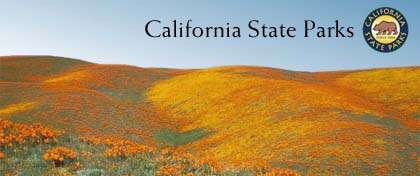Antelope Valley California Poppy Reserve
|
|
The Antelope Valley California Poppy Reserve is a California wildlife reserve located in the rural westside of the Antelope Valley in northern Los Angeles County. Constitutionally, it is a state park. Its namesake is the state flower, the California Poppy.
This 1,745 acre (7 km²) State Reserve, nestled in the Antelope Buttes 15 miles (24 km) west of downtown Lancaster, is located on California's most consistent poppy-bearing land. Other wildflowers include owl's clover, lupine, goldfield, cream cups and coreopsis, to name a few. They share the desert grassland to produce a mosaic of color and fragrance each spring. As unpredictable as nature - the intensity and duration of the wildflower bloom varies yearly.
Seven miles (10 km) of trails, including a paved section for wheelchair access, wind gently through the wildflower fields. The broad views of this landscape provide eyefuls of brilliant wildflower colors. Whether you most enjoy expansive fields of wildflower colors and fragrance or the close-up study of a single flower, this is the place to visit. In good bloom years, the Reserve can be very crowded, especially on weekends. When the afternoon winds come, the poppies typically close their blooms, so mornings are recommended for the best poppy viewing.
Location - Directions
The reserve is located 15 miles (24 km) west of the Antelope Valley Freeway (California State Route 14) on Lancaster Road near the city of Lancaster. Exit the freeway at Avenue I (name changes to Lancaster Road) and drive west 15 miles to the Reserve's visitor center, found on the north side of Lancaster Road on top of the small hill.
Latitude/Longitude: 34.7502 / -118.3816
More about the Reserve
The reserve is at an elevation ranging from 2600 - 3000 feet. It is in the Mojave Desert climate zone.
California law forbids the picking of any wildflowers in the Reserve, including poppies.
The reserve is a natural area, where only day use (hiking and picnicking) is allowed.
California State Parks does not water to stimulate the flowers. Park management has excluded sheep from grazing the hillsides. Until the early 1970s sheep once grazed the buttes in the western Antelope Valley. Pronghorn antelope grazed long before then, until the railroad first arrived in 1876.
California Poppies grow best where there is some disturbance. This can be man made by various means: such as disking by farming practices or natural means, such as sheep or pronghorn grazing/walking or fire.
California State Parks has a prescribed burn program that uses fire as a natural tool to manage grassland vegetation .
Fire has been a part of the management practices for the Poppy Reserve since 1994. Prescribed burning has decreased the exotic species, reduced the ground cover and litter, and permitted the native species of wildflowers to grow and bloom better.
The Reserve was officially established in 1976 through the efforts of artist Jane H. Pinheiro and other local residents.
External Link
Photos of California Poppies in Antelope Valley - Terra Galleria (http://www.terragalleria.com/california/california.antelope-valley.html)

